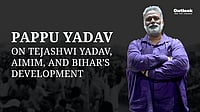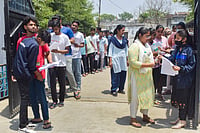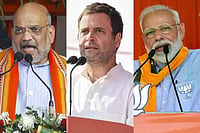In the subsequent weeks, which saw a brief, thoughtful lull, the US defined more lucidly what its war objectives were—it was to nab bin Laden, destroy Al Qaeda’s global network and ensure Afghanistan no longer exported terror. And Washington described in good measure its secondary war objective: were the Taliban to refuse to hand over bin Laden to the US, then Afghanistan would be bombed and a regime-change effected.
No one expected the maverick Taliban supremo, Mullah Omar, to acquiesce easily to overweening US demands. In October, US warplanes lit the sky over Afghanistan, raining bombs and missiles. Kabul fell on November 13. In December, Hamid Karzai was sworn in as head of the interim government of Afghanistan, heralding the success of the US.
It was then thought the US and allies would, in a month or two, smoke out Al Qaeda and other Taliban leaders from their mountain hideouts. There was now a friendly government in power, there were also US Marines and international troops on the ground, capable of gathering intelligence and launching search-and-kill operations in the treacherous terrain of Afghanistan. Underlying the furious hunt was the assumption—it stemmed from the objective Bush himself had spelt out—that the war couldn’t be declared won until bin Laden had been caught or conclusive evidence of his death shown to the people of the US.
But bin Laden—and much of the Taliban leadership—remains elusive, neither caught nor proved to have been killed. No wonder the US, unlike many of its allies, has been circumspect. Only recently, Lt Gen Dan K. McNeil, the US military commander in Afghanistan, declared: "We haven’t won, but we’re winning." Many saw this as a subtle climbdown from the euphoria of last December. Similarly, the US central command head, Gen Tommy Franks, has said that the US will need to stay another year in Afghanistan and that the war against terrorism should be extended to countries neighbouring Afghanistan. On their trips to the region, US officials have been careful not to mention bin Laden, and under persistent questioning from reporters, insist the war against terrorism wasn’t directed against one man but his entire network.
The prolonged operation, for all its other accomplishments, is up against an as-yet irresolvable question: is Osama dead or alive? Sections of the Pakistani intelligence feel he was killed in the fierce bombing of Tora Bora last year. This school of opinion puts out that Al Qaeda has kept his death secret for perpetuating the Osama myth, prevent demoralisation in its ranks and ensure that the US doesn’t derive satisfaction in claiming a decisive victory in the war against terrorism.
Others, though, scoff at this theory, claiming it is impossible to conceal the death of the most wanted man. They cite the instance of Shaikh Taseer Abdullah, also known as Mohammad Ateh, who was bin Laden’s most trusted aide. As soon as Ateh was killed in US bombing last year, his family announced his death. Similarly, when the wife and daughters of Dr Ayman al-Zawahiri, often referred to as the brain of Al Qaeda, died in a bombing raid near Kandahar, the media splashed the news.
Speculations abound about bin Laden’s hideout. Some feel he criss-crosses through the porous Pakistan-Afghanistan border. Islamabad denies his presence in the tribal areas but its disavowal has little credence in western capitals. Others think he could have escaped into Iran, or from there to Iraq or Yemen. Those affiliated to the Northern Alliance insist he shifts among places in eastern and southern Afghanistan. Hamid Karzai, whom the Americans trust and rely on, claims he doesn’t have enough evidence to even speculate about bin Laden’s whereabouts. There are other fantastic theories—that he is in the snow-covered Pamir mountains, or in Kashmir, even in China’s Muslim-dominated Xinjiang province.
But if bin Laden can’t be presumed dead, he can’t be presumed alive either. Most agree that only a fresh videotape showing him speaking on a contemporary development will conclusively prove he is still alive. Considering bin Laden’s penchant for publicity, and exploiting the medium of television to spread his message, his silence since December at least testifies to his inability to have himself filmed. In other words, though bin Laden could be alive, it can be assumed he finds his circumstance risky.
Though the Americans are loath to admit it publicly, there is little doubt that all major military operations in eastern and southern Afghanistan—the Tora Bora bombings, Operation Anaconda, Operation Mountain Lion, Operation Condor and Operation Buzzard—were aimed at netting bin Laden and his lieutenants such as Dr al-Zawahiri. Only last fortnight, Operation Mountain Sweep, in south-eastern Afghanistan, was called off. The operation was launched following intelligence reports that important Al Qaeda and Taliban leaders were hiding in a chain of villages. When the international troops swooped down on the area, they were aghast to find villages completely deserted. It is believed warlords assisting the US informed the militants about the impending operation, obviously choosing to play the cat-and-mouse game both ways.
Let alone bin Laden, the US hasn’t managed to eliminate or nab several Taliban leaders. Mullah Omar, for instance, has been frequently sighted in his former strongholds of Urozgan, Helmand and Kandahar in south-western Afghanistan. None of other important Taliban leaders, including Jalaluddin Haqqani, Mohammad Hasan Akhund, Mohammad Hasan Rahmani, Abdul Jalil, Akhtar Mohammad Usmani, Abdul Kabir, Biradar Akhund, Abdul Razzaq, Amir Khan Mutaqqi, Mohammad Tayyab Agha, etc, have been captured. The few senior Taliban leaders now in US captivity were mostly captured by the Pakistan government. They are former foreign minister Wakil Ahmad Muttawwakil, Herat governor Khairullah Khairkhwa, deputy defence minister Mohammad Fazil Mazloom and Balkh (Mazar-e-Sharif) governor Noorullah Noori.
Most international-led search missions targeted Khost, Paktia and Paktika provinces in southern and south-eastern Afghanistan, aiming at plugging the mountain routes leading into Pakistan’s semi-autonomous tribal belt across the Durand Line. During their sweep through the mountainous territory of Paktia, the 1,700-strong British Marines destroyed ammunition dumps, inspiring their commander Brig Roger Lane to claim the war in Afghanistan was all but over. But what Lane didn’t know was that these dumps belonged to mujahideen commanders allied to the US, and which it had consequently refrained from targeting. Ultimately, Lane was replaced for his pyrrhic victory.
The limited success in Afghanistan prompted the US to pressure Islamabad into allowing American personnel to hunt the fugitives across the border. Pakistan and the US have captured about 400 Taliban and Al Qaeda operatives, the most important being bin Laden’s aide, Abu Zaida. He and some 330 of those arrested have been handed over to the US.
But even as the US has presumably destroyed the command and control structure of Al Qaeda in Afghanistan, the Americans and their western and Afghan allies have, in the past few months, now come under increasing guerrilla attacks. The US has claimed to have lost 40 soldiers in its ongoing Afghanistan operations, though not all to enemy fire. But others claim their casualty is higher. The tardy pace of reconstruction, the confining of the international force to Kabul, and the heart-burning among the majority Pashtoons over the dominance of the Northern Alliance in the interim government are other destabilising factors in the war against terrorism. All these Washington would have forgotten had it the satisfaction of getting Osama bin Laden, dead or alive.

























